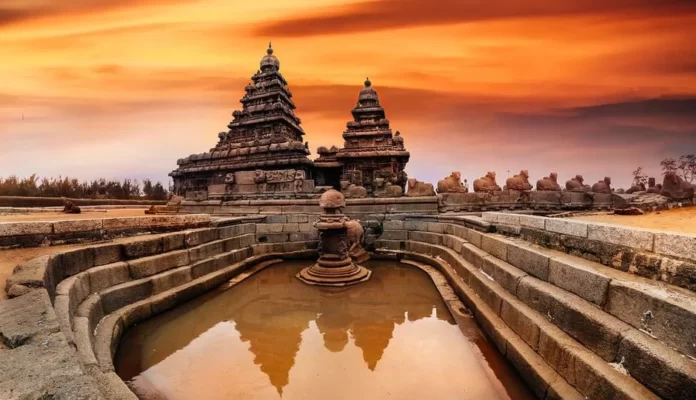The Shore Temple is a remarkable UNESCO World Heritage Site and is also known as Mahabalipuram Temple. Here we have shared 19 facts about Shore Temple.
It is one of the prominent attractions in the region and is known for its architectural brilliance and historical significance.
Shore Temple is located in Mahabalipuram (also known as Mamallapuram), a coastal town in the Kanchipuram district of Tamil Nadu, India.
The location of the Shore Temple on the shores of the Bay of Bengal offers breathtaking views, especially during sunrise and sunset. The temple is surrounded by sandy beaches and other ancient rock-cut structures, making it a captivating destination for history enthusiasts and spiritual seekers.
Facts About Shore Temple (Mahabalipuram)
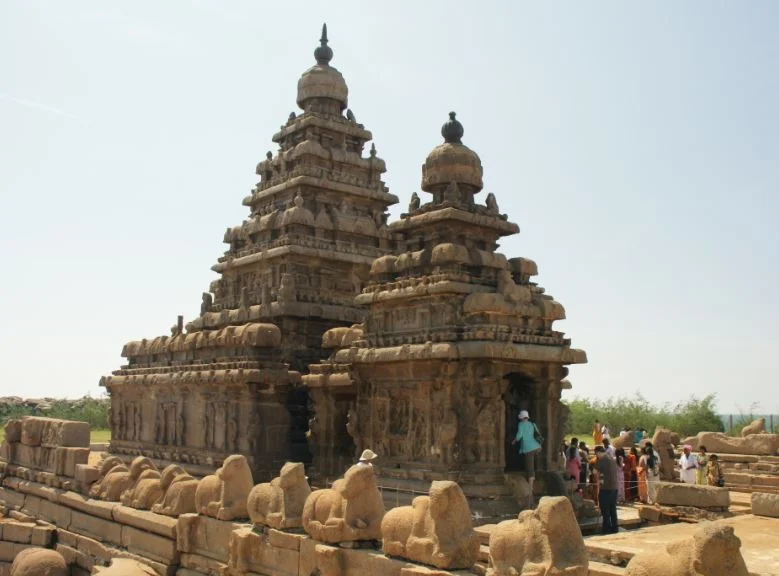
Here are 19 interesting facts about Shore Temple in Mahabalipuram.
1. About Shore Temple
- The Shore Temple is a prominent monument located in Mahabalipuram, Tamil Nadu, India.
- It is one of the oldest structural stone temples in South India, dating back to the 8th century CE.
- The temple complex is recognized as a UNESCO World Heritage Site for its historical and architectural significance.
- The Shore Temple is dedicated to Lord Shiva and is an important pilgrimage site for Shaivites.
- The temple gets its name due to its proximity to the shore of the Bay of Bengal.
2. Historical facts about Shore Temple
The Shore Temple is a complex of three ancient temples, primarily dedicated to Lord Shiva. It was built during the 8th century CE by the Pallava dynasty, and its unique feature is that it overlooks the Bay of Bengal.
The temple complex showcases exquisite Dravidian architecture, with intricate carvings and sculptures depicting various mythological scenes.
- The Shore Temple was built during the reign of the Pallava dynasty, which was known for its architectural achievements.
- The Pallava kings were great patrons of art, literature, and temple construction.
- The temple stands as a remarkable example of the architectural style and craftsmanship of the Pallava dynasty.
- The intricate carvings and sculptures on the temple walls depict various mythological stories and deities.
- The Pallava rulers left a significant cultural and architectural legacy, with the Shore Temple being one of their crowning achievements.
3. Dravidian Architecture
The Shore Temple is a classic example of Dravidian temple architecture, characterized by its pyramid-shaped towers (gopurams) and intricate stone carvings.
- The temple follows the typical layout of a Dravidian temple with a sanctum, a mandapa (hall), and a tower.
- The temple is made of granite, and the sculptures on the walls showcase the skilled craftsmanship of the artisans.
- The gopurams of the temple are adorned with intricate motifs, including images of gods, goddesses, celestial beings, and mythical creatures.
- The Dravidian architectural style of the Shore Temple has influenced temple construction in South India for centuries.
4. Three Temples inside Shore Temple Complex
The main shrine of the Shore Temple is dedicated to Lord Shiva, while the other two temples are dedicated to Lord Vishnu. The temple complex also houses several Nandi statues (sacred bulls) and various mandapas (pillared halls) that add to its grandeur.
- The Shore Temple complex originally consisted of three temples, of which two are now standing.
- The main shrine is dedicated to Lord Shiva and faces east, symbolizing the rising sun.
- The other two shrines were dedicated to Lord Vishnu and Lord Shiva’s consort, but they have been largely eroded over time.
- The surviving temples are interconnected and share a common compound.
- The layout and design of the Shore Temple complex showcase the religious harmony and artistic excellence of the Pallava dynasty.
5. Unique Location

- The Shore Temple is strategically located on a rocky outcrop near the shore, which adds to its visual appeal.
- The temple’s design and placement make it appear as if it is emerging from the sea, giving it a majestic and awe-inspiring presence.
- The architecture of the temple is designed to withstand the coastal weather and the erosive action of the sea.
- The temple complex includes a large stone wall and a Nandi (bull) statue facing the main shrine.
- The natural and architectural beauty of the Shore Temple attracts tourists and devotees from around the world.
6. Intricate Sculptures facts about Shore Temple
- The walls of the Shore Temple are adorned with exquisite sculptures that depict various deities, celestial beings, and mythological stories.
- The sculptures showcase the mastery of the artisans in capturing intricate details and expressions.
- The sculptures depict scenes from Hindu epics like the Mahabharata and the Ramayana.
- The images of gods and goddesses such as Lord Shiva, Lord Vishnu, and Goddess Durga are prominently featured.
- The sculptural art of the Shore Temple is a testament to the rich cultural and religious heritage of ancient India.
7. Five Rathas
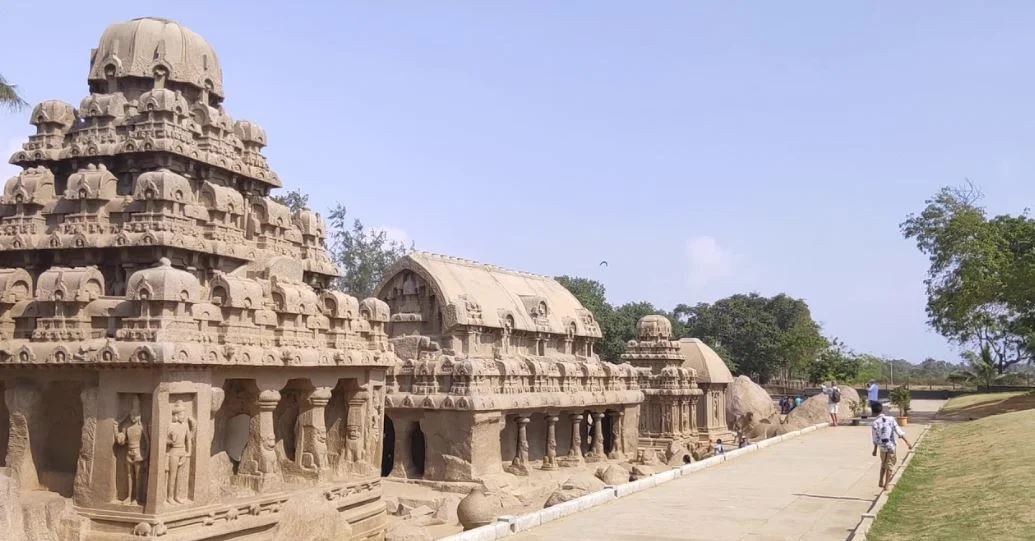
- The Shore Temple complex also includes the Five Rathas, a group of monolithic rock-cut temples.
- The Five Rathas are named after the Pandava brothers from the Mahabharata epic and are dedicated to different deities.
- The rathas showcase different architectural styles, including Dravidian, Nagara, and even Buddhist influences.
- Each ratha is carved from a single stone and represents a different chariot or vimana-like structure.
- The Five Rathas are a significant attraction within the Shore Temple complex and provide insights into the evolution of temple architecture.
8. Iconic Sunset Views
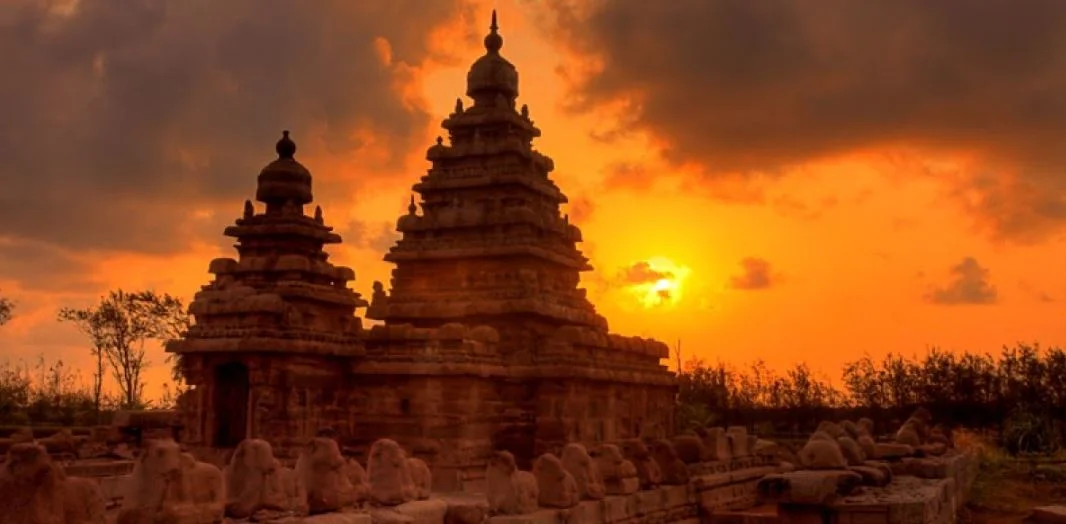
- The Shore Temple is a popular spot for tourists to witness breathtaking sunset views over the Bay of Bengal.
- The temple’s location by the sea provides a stunning backdrop as the sun sets on the horizon.
- Visitors can enjoy the serene atmosphere and capture memorable photographs during the golden hour.
- The combination of the temple’s architectural splendor, the rhythmic sound of the waves, and the vibrant colors of the sunset create a mesmerizing experience.
- Watching the sunset at the Shore Temple is considered a must-do activity for tourists visiting Mahabalipuram.
9. Archaeological facts about Shore Temple
- The Shore Temple and the surrounding monuments have attracted the attention of archaeologists and historians.
- The temple complex has provided valuable insights into the art, culture, and maritime history of ancient India.
- Excavations and research at the site have unearthed ancient artifacts, inscriptions, and evidence of early trade and seafaring activities.
- The preservation and restoration efforts at the Shore Temple have been undertaken to safeguard this invaluable cultural heritage.
- The temple complex stands as a living testimony to the glorious past of the Pallava dynasty and their contributions to Indian art and architecture.
10. UNESCO World Heritage Site
- The Shore Temple, along with other monuments in Mahabalipuram, was designated as a UNESCO World Heritage Site in 1984.
- This recognition highlights the universal cultural and historical significance of the temple complex.
- The UNESCO status ensures the protection and preservation of the site for future generations.
- It also promotes tourism and awareness about the rich heritage of Mahabalipuram.
- The inclusion of the Shore Temple in the prestigious list reinforces its status as a global heritage site.
11. Monsoon Architecture
- The Shore Temple exhibits unique monsoon architecture, characterized by its sloping roofs and intricate drainage systems.
- The design of the temple incorporates features that effectively channel rainwater away from the main structure.
- The roof of the temple is designed with a gentle slope to prevent water stagnation and seepage.
- The intricate drainage system includes carved stone spouts and canals to carry rainwater away from the temple.
- The monsoon architecture reflects the ingenuity of the Pallava architects in creating structures that could withstand the heavy monsoon rains.
12. Submerged Temples
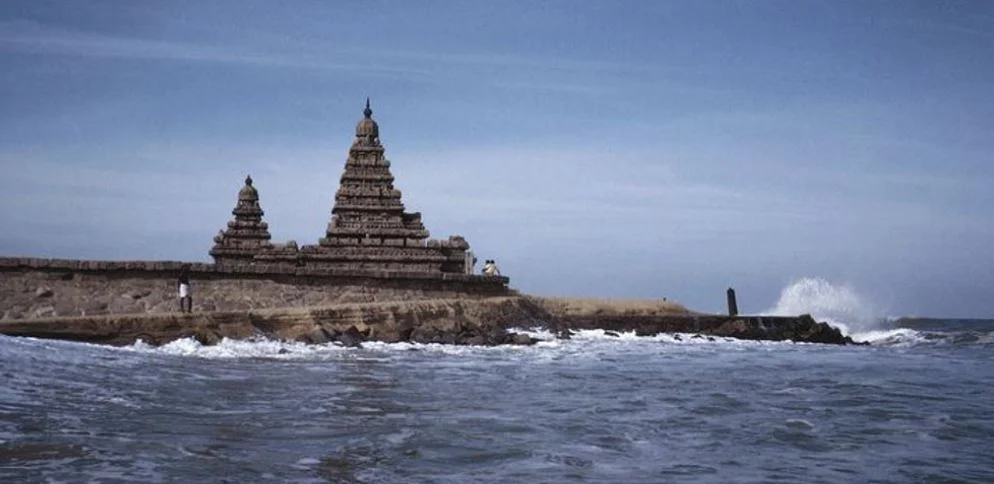
- Over the centuries, several temples and structures around the Shore Temple were submerged due to coastal erosion.
- These submerged temples are now protected as underwater heritage sites.
- The submerged structures provide important insights into the ancient history and architecture of Mahabalipuram.
- Efforts are being made to study and preserve these submerged temples, showcasing the rich heritage hidden beneath the sea.
- The existence of the submerged temples reinforces the historical significance and maritime connections of Mahabalipuram.
13. Unique Granite Carvings
- The Shore Temple is primarily made of granite, which was intricately carved to create the temple’s distinctive features.
- The granite used in the temple’s construction was sourced from nearby quarries, showcasing the architectural skills of the Pallavas.
- The carvings on the granite walls depict various deities, celestial beings, animals, and intricate floral motifs.
- The precision and detailing of the granite carvings highlight the mastery of the sculptors in bringing the stone to life.
- The durability of granite has contributed to the preservation of the carvings, allowing visitors to admire their beauty to this day.
14. Cultural facts about Shore Temple
- The Shore Temple holds immense cultural significance as a religious, architectural, and artistic marvel.
- It continues to be an active place of worship, attracting devotees and pilgrims from different parts of the country.
- The temple complex serves as a center for religious and cultural activities, hosting festivals, music concerts, and dance performances.
- The temple’s rich history and architectural grandeur have inspired numerous artists, poets, and writers over the centuries.
- The Shore Temple is a symbol of pride and heritage for the local community and is deeply intertwined with the cultural fabric of Mahabalipuram.
15. Intertwining of Legends
- Legends and folklore surround the Shore Temple, adding to its mystical aura.
- According to local legends, the temple was believed to be one of the seven temples created by the Pandava brothers during their exile.
- Another legend states that the temple was once part of a larger complex that included seven temples dedicated to the seven celestial deities.
- The intertwining of legends with the temple’s history adds a sense of enchantment and intrigue for visitors.
- The tales and stories associated with the Shore Temple reflect the rich oral traditions and mythical beliefs of the region.
16. Sound and Light Show
- The Shore Temple offers an immersive sound and light show that narrates the history and legends associated with the temple.
- The show takes place in the evening and provides visitors with a captivating visual and auditory experience.
- Through the use of lights, projections, and narrations, the show brings the temple’s history and mythology to life.
- The sound and light show is a popular attraction, allowing visitors to delve deeper into the cultural and historical significance of the temple.
- It is a mesmerizing way to learn about the temple’s past while enjoying the ambiance of the surroundings.
17. Restoration Efforts
- The Shore Temple has undergone extensive restoration work to preserve its architectural integrity.
- Conservation efforts have been carried out to repair weathering, erosion, and damage caused by time and human activity.
- Skilled artisans and experts have worked on the restoration, aiming to maintain the temple’s original form and structure.
- The restoration efforts have included cleaning, stabilizing the structures, reinforcing the foundations, and addressing structural vulnerabilities.
- These efforts ensure that future generations can continue to appreciate the grandeur and beauty of the Shore Temple.
18. Influence on Temple Architecture
- The Shore Temple’s architectural style and design have had a profound influence on subsequent temple construction in South India.
- Its unique features, such as the pyramidal tower, intricate sculptures, and monsoon architecture, have become hallmarks of Dravidian temple architecture.
- Many temples built during later periods were inspired by the design elements and craftsmanship seen in the Shore Temple.
- The temple’s influence extends to various architectural elements, including entrance gates, mandapas, and the arrangement of sanctums.
- The Shore Temple stands as a pioneering example that set the stage for the evolution of temple architecture in the region.
19. Tourism and Visitor Experience
- The Shore Temple attracts a large number of tourists, history enthusiasts, and devotees throughout the year.
- Visitors can explore the temple complex and marvel at the architectural beauty and intricate carvings.
- The serene surroundings and the gentle sound of the waves create a tranquil atmosphere for contemplation and reflection.
- Tourists can engage with local guides to learn more about the temple’s history, significance, and architectural nuances.
- The Shore Temple complex also offers amenities such as souvenir shops, restaurants, and well-maintained pathways for a comfortable visitor experience.
How to Reach Shore Temple?
Mahabalipuram is well-connected by road and can be easily reached from nearby cities like Chennai and Pondicherry. The town is also known for its stone sculptures, ancient caves, and other magnificent temples, making it a popular tourist destination.
Visiting the Shore Temple allows one to delve into the rich cultural and architectural heritage of ancient South India. The intricate craftsmanship, the serene ambiance, and the scenic beauty of the location make it a must-visit site for both devotees and travelers.
Related Posts
- 21 Facts About Vaishno Devi
- 19 Facts About Amarnath
- 21 Facts About Kedarnath
- 27 Facts About Badrinath
- 16 Facts About Gangotri
- 17 Facts About Yamunotri
